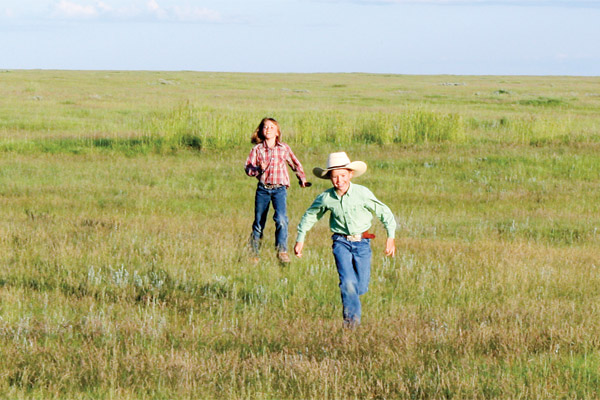
Mile after mile, earth once anchored by native grasses was blowing away, turning the heart of Canada’s Wild West into what would be known as the Dust Bowl. It was the Dirty Thirties, and as the prairie’s soil disappeared, so did her people.
The timing couldn’t have been worse?—?the world was held fast in the grip of the Great Depression. Desperate producers fled their homesteads en masse, fleeing to cities in hope of finding work. Instead, they found they had traded their property for more poverty.
The Dust Bowl was created by a perfect storm?—?years of falling grain prices, a severe drought and land mismanagement. The hardest-hit parts were in the dry Palliser Triangle?—?southern belt of Alberta and Saskatchewan. Thousands and thousands abandoned their land, and those who remained were sustained by relief money.
The federal government intervened to stem the bleeding and in 1935, created the Prairie Farm Rehabilitation Administration (PFRA). Described as one of Canada’s greatest success stories, an intense cascade of initiatives addressed erosion, grass management, water access and irrigation.
Now, after 77 years of perseverance and innovation, the PFRA is being terminated by the federal government and nowhere is the loss felt more deeply than in southwest Saskatchewan.
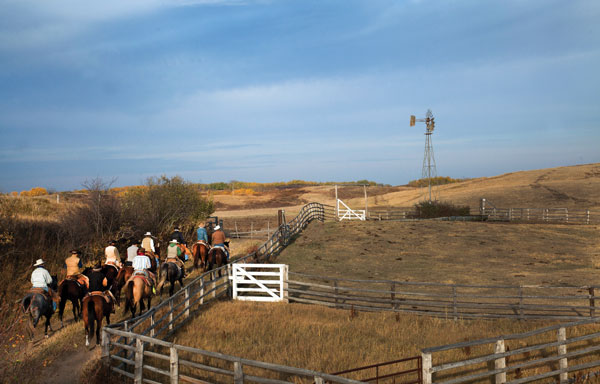
“This community is in the fight for its life right now. The pasture system here is such a huge part of the community,” said Bryan Tully, manager of the Govenlock PFRA Community Pasture.
Bryan manages over 100 sections of grazing land near Govenlock, one of three such PFRA pastures in the southwest corner of Saskatchewan that run along the U.S. border for 25 miles. The nearest settlement is Consul, a village of less than 100 people.
While 300 sections may seem like a staggering amount of land, one glance at a PFRA pasture map of Alberta, Saskatchewan and Manitoba reveals 85 community pastures. While the PFRA presence is certainly felt across the prairies, in the isolated Southwest, it is a way of life.
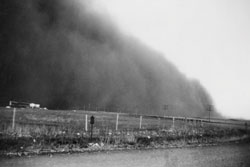
The children of the PFRA employees comprise 23 per cent of the student body at Consul’s only school. If the pastures cease to operate, families like Bryan’s will be driven out.
“We pay rent, we’re expected to own our own horses and tack in order to do the job and that’s fine?—?lots of cowboys are like that. But now we don’t have a job, and it was a condition of employment to live on the pasture. So now we don’t have a home either and all of a sudden, we just about don’t have a school.”
It’s not just Consul and the RM of Reno affected in the Southwest?—?the entire region will feel the loss from Maple Creek to Fox Valley, and east to Herbert. But it will be the most isolated communities who suffer more?—?ironically, the very same communities who tried the hardest to attract and retain their populations.
In 2009, producers learned the federal government wanted to divest of its PFRA irrigation projects, giving communities until 2017 to take them over. The Southwest is home to several irrigation projects, including those near Consul, Eastend, Maple Creek, and Val Marie.
At Maple Creek, patrons of the PFRA irrigation project are in a bind?—?the flood of 2010 damaged a critical weir and though the infrastructure still belongs to the federal government, they won’t cover the $3 million repair. The patrons are still trying to negotiate with the government?—?for many, their operations depend on a favourable outcome.
The Val Marie area, like Consul, is geographically isolated and incredibly arid. Producers rely on the irrigated land to grow their hay crop and if the water dries up, feed will have to be brought in from outlying areas. The farther producers are from the TransCanada Highway, the more they’ll pay for feed. In drought years, sometimes the only option is an auction sale.

First Blow
It was announced in Ottawa August 10 that the Governments of Canada and Manitoba are shutting down the first five community pastures. (Westbourne, Lakeview, Gardenton, Pansy and Sylvan Dale.) The federal government will extend grazing in the first round of pastures to be divested to both Manitoba and Saskatchewan, by one year, until the end of 2013.
“AAFC will continue working with the Governments of Manitoba and Saskatchewan, who own over 90 per cent of the pasture land, to transition the land to users with a more direct interest and phase out federal involvement in management. This will occur over a six-year period to ensure the process optimizes future economic and employment opportunities for the rural communities affected.”
—?Federal Government press release from the Office of the Honourable Gerry Ritz.
Now retired, Don Kissel began managing the PFRA Consul Nashlyn Irrigation Project in 1967 and now, he’s working with the community to try and save it.
“They won’t give us any answers. They just keep talking in circles as far as I’m concerned,” Don lamented.
Patrons currently pay about $16 an acre for irrigation, but if they take over the operation privately, operation costs could average $50 an acre?—?and that’s barring any catastrophic failures or repairs. Many producers have bought land at the higher-value irrigated price, and if the irrigation ceases, the land value will plummet to devastating dryland lows. Others have invested as much as $1,000 an acre to level the land and improve it to receive irrigation and losing the project could ruin some operations.
While the irrigation issue had been ongoing, the news that all of the PFRA was being dismantled came as a shock and Bryan says residents feel betrayed.
“A lot of these families have been in the PF right from day one. A lot of them gave up land to form these blocks of pastureland. Then all of a sudden, the rug was pulled out from under them.”
The federal government is handing the PFRA land to the provincial governments, a politically brilliant move as ultimately, it will be the provinces that take the heat for allowing the public land to become private. For the Saskatchewan Party who first took power in 2007 thanks in large part to the rural vote, inheriting the PFRA land is like catching a political hand grenade. Despite the potential fallout, it seems selling the land is a gamble the Sask. Party is willing to take.
“We would like to provide the existing patrons with the first opportunity to purchase these lands,” said Saskatchewan Ag Minister Lyle Stewart, who also said they will work with stakeholders to decide the best course of action to deal with the transition. As a result, a five-member advisory committee was formed to represent the ranching sector.
As with the irrigation projects, it’s likely the provincial governments will try to negotiate a selling price for the pastures in hope that the patrons who currently use them will be willing to take co-operative ownership of them. Producers are just beginning to recover from years of low cattle prices and many aren’t in a position to borrow. But without those critical grazing lands, they won’t be able to feed the stock they already have.
“A lot are looking at (losing) a third to one-half of their herd. There’s a sense of panic, a sense of anger and there’s a sense of real urgency,” Bryan said.
Residents worry the land will end up in the hands of absentee owners. In recent years, a lot of land in the Southwest has been purchased by Albertans infatuated with Saskatchewan’s prices. But the land is so marginal that in some areas, a quarter can only run four pair without being damaged. Unfamiliar with the land and its delicacy, these owners often leave the land overgrazed?—?which was one of the practices leading to the Dust Bowl 80 years ago.
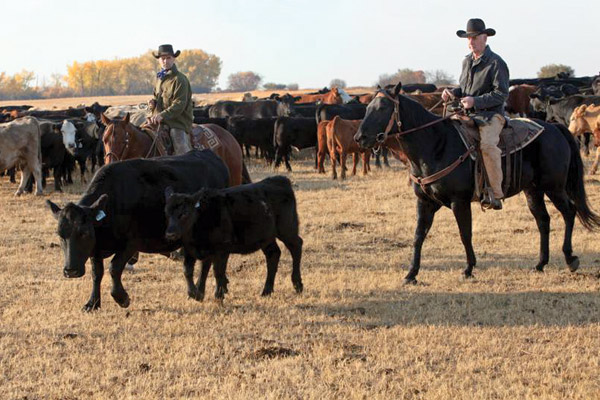
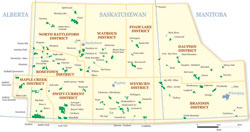
- Click on the image to see a larger version map showing the PFRA pastures on the Canadian Prairies. Map courtesy of the Agri-Enviroment Services Branch.
Additionally, absentee owners don’t increase a community’s viability?—?the animals are brought in and then moved out. Local businesses aren’t patronized, there are no new children to attend the schools, and the downward spiral continues.”That oil country is hard on our dry land down here,” Don said.Iconic prairie species such as burrowing owls, rattlesnakes, swift fox, pronghorn antelope and ferruginous hawks exist in a delicate balance in the Southwest. When the PFRA was formed, the region was a wasteland, and its tenuous recovery has been painstakingly slow?—?but it has recovered. And it’s not just the PFRA?—?throughout the region, ranchers have taken conservation to heart. The excellent stewardship of the land enabled the government to create Grasslands National Park in the heart of region as a prairie showcase of biodiversity.”That’s what really hurts me personally. We’re here because we want to see that on the pastures,” says Bryan. “We work every day to have that equilibrium between the critters and the grass and the cows. To see the possibility of it all going to waste is heartbreaking.”Sheri Monk writes for an agricultural publication out of Alberta, and is also a freelance columnist and investigative reporter.
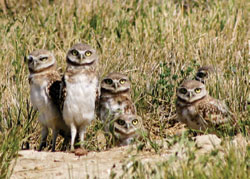
- PFRA pastures are home to several threatened or endangered species of wildlife. In fact, 49 of 68 PFRA pastures contain species at risk. PFRA played an important role in the early phase of the Swift Fox release program, is actively involved in recovery programs for the sage grouse and burrowing owl (pictured) and currently is the steward of a black-tailed prairie dog colony. Photo courtesy PCAP/Ben Krenzke.
Also Gone… Indian Head Shelterbelt CentreThe PFRA Shelterbelt Centre was established at Indian Head, Sask., in 1901 to supply prairie hardy tree and shrub seedlings free to producers. By 2004, over 590,000,000 seedlings have been distributed to 645,615 applicants throughout the Prairies.
Selection and limited distribution of hardy trees first began in the late 1800s at the Agriculture Experimental Station in Indian Head. To meet growing demand, the Department of Interior established the Forest Nursery Station, which shipped 106,000 trees to 92 settlers in its first year (1902). The program became more popular every year and by 1906, 2 million trees were being shipped.
The Shelterbelt Centre at Indian Head is 640 acres (256 ha), produced 29 hardy tree and shrub species, and distributed over 5 million trees and shrubs to as many as 10,000 prairie clients annually.
During the severe drought of the 1930s, Shelterbelt Centre staff worked with the newly formed PFRA to plant field shelterbelts and demonstrate their use for soil conservation. In 1963, the Shelterbelt Centre at Indian Head Saskatchewan became part of PFRA.The benefits of shelterbelts are numerous. Shelterbelts reduce wind speed and thereby create a microclimate for yards, gardens, and crops. On average, a mature 5-row shelterbelt, with at least 2 rows of conifers, planted around a farmhouse will reduce its heat requirements by 25 per cent.
The snow trapping and wind reduction effect of field shelterbelts reduces wind erosion and can increase yields in dry years. Other benefits include habitat and travel corridors for wildlife and birds. Officially, by December 2013, federal operations under the Prairie Shelterbelt Program will shut down.Shelterbelt ProgramAt press time, so far, one grassroots organization, Support the Friends of the Shelterbelt Program, has sprung up and no doubt there will soon be an organization to save the PFRA pasture system as well.The concerned citizens group has formed to convince the Federal Government to reconsider this decision and to inform the public about the situation.
You can contact the group by emailing saveshelterbeltprogram?@?gmail.com They can send you a copy of the petition so you can circulate it in your area. An alternative is to add your name to an electronic petition at www.ipetitions.com/petition/save-the-prairie-shelterbelt-program. Check Facebook at “Save the Prairie Shelterbelt Program” for links and other information.If you want the Shelterbelt program and the PFRA Pastures to continue, write to the Honourable Mr. Gerry Ritz, Minister of Agriculture and Agri-food at: House of Commons, Ottawa, Ont., K1A 0A6 and ask him to reconsider the decision. No postage is required. Or you can email him at gerry.ritz?@?parl.gc.ca. Office phone: 613-995-7080 or 306-445-2004.
Sidenote:
The total acreage controlled by the PFRA is 2,295,609 acres (929,000 ha) in the Prairie region.













